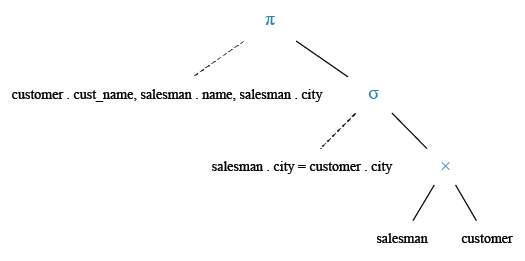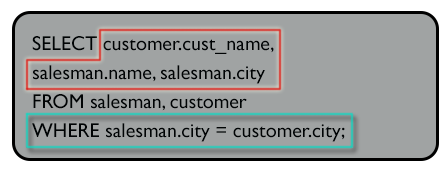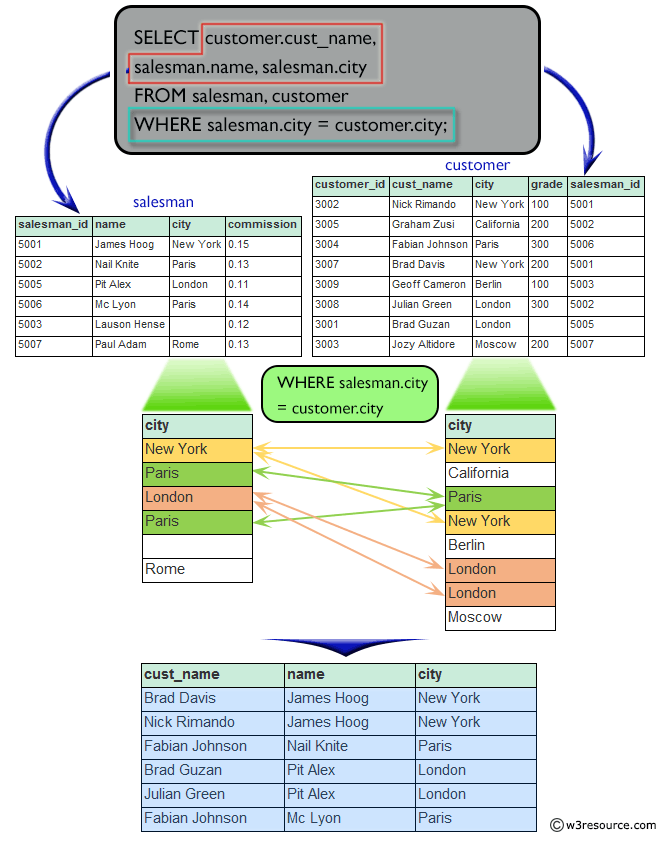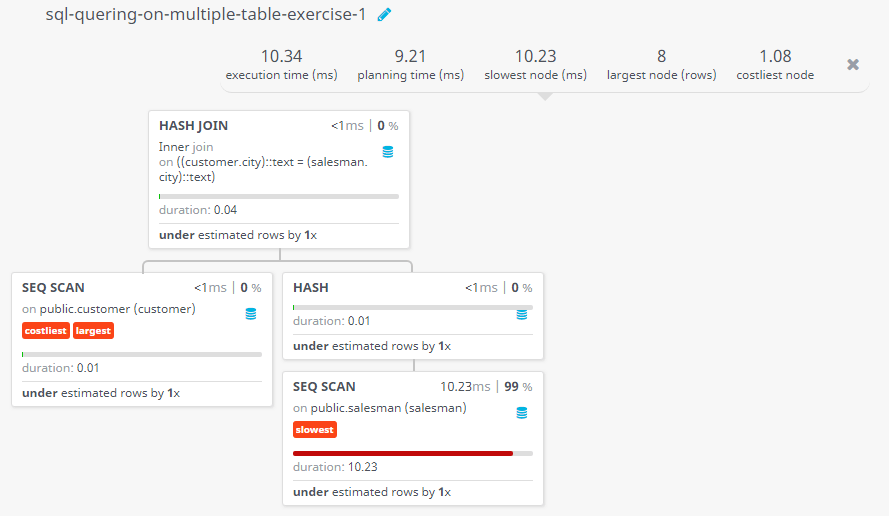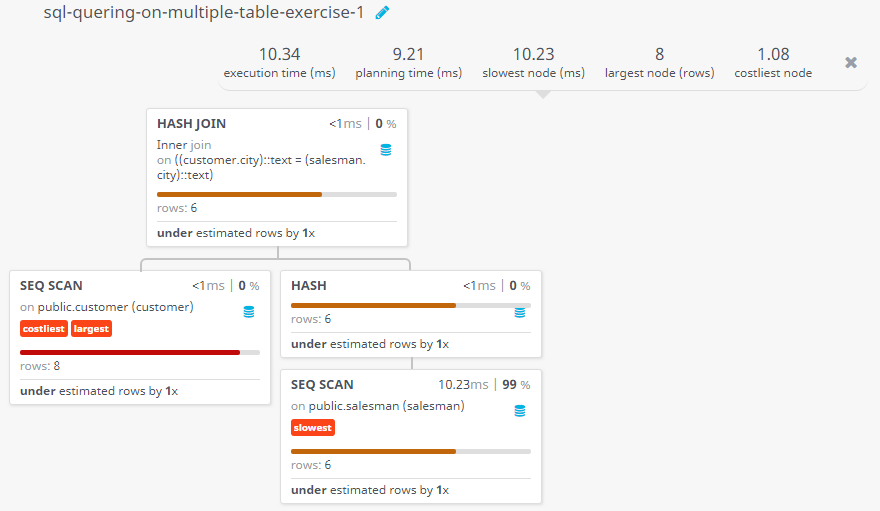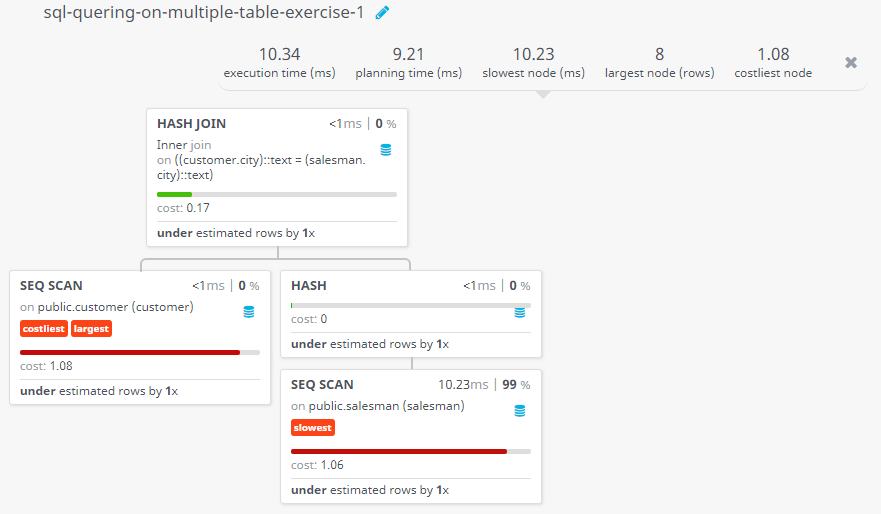SQL Exercises: Customer and salesmen who lives in the same city
Sales & City Matching
From the following tables, write a SQL query to find the salespeople and customers who live in the same city. Return customer name, salesperson name and salesperson city.
Sample table: salesman
salesman_id | name | city | commission
-------------+------------+----------+------------
5001 | James Hoog | New York | 0.15
5002 | Nail Knite | Paris | 0.13
5005 | Pit Alex | London | 0.11
5006 | Mc Lyon | Paris | 0.14
5007 | Paul Adam | Rome | 0.13
5003 | Lauson Hen | San Jose | 0.12
Sample table: customer
customer_id | cust_name | city | grade | salesman_id
-------------+----------------+------------+-------+-------------
3002 | Nick Rimando | New York | 100 | 5001
3007 | Brad Davis | New York | 200 | 5001
3005 | Graham Zusi | California | 200 | 5002
3008 | Julian Green | London | 300 | 5002
3004 | Fabian Johnson | Paris | 300 | 5006
3009 | Geoff Cameron | Berlin | 100 | 5003
3003 | Jozy Altidor | Moscow | 200 | 5007
3001 | Brad Guzan | London | | 5005
Sample Solution:
-- This query selects specific columns ('customer.cust_name', 'salesman.name', 'salesman.city') from the 'salesman' and 'customer' tables.
-- It retrieves data where the 'city' column in the 'salesman' table matches the 'city' column in the 'customer' table.
SELECT customer.cust_name, salesman.name, salesman.city
-- Specifies the tables from which to retrieve the data (in this case, 'salesman' and 'customer').
FROM salesman, customer
-- Specifies the condition for joining the 'salesman' and 'customer' tables based on the equality of the 'city' columns.
WHERE salesman.city = customer.city;
Output of the query:
cust_name name city Nick Rimando James Hoog New York Brad Davis James Hoog New York Julian Green Pit Alex London Fabian Johnson Mc Lyon Paris Fabian Johnson Nail Knite Paris Brad Guzan Pit Alex London
Code Explanation:
The said query in SQL that joins the 'salesman' and 'customer' tables based on the city column. The result set includes the customer name (cust_name), salesman name (name), and city from the salesman table. The WHERE clause specifies the join condition between the two tables, which is that the city column must be equal in both tables.
Relational Algebra Expression:
Relational Algebra Tree:
Explanation:
Visual presentation:
Go to:
PREV : SQL Query on Multiple Tables Exercises Home
NEXT : Customer-Salesperson Association.
Practice Online
Query Visualization:
Duration:
Rows:
Cost:
For more Practice: Solve these Related Problems:
- Write a SQL query to list each salesperson along with the count of customers living in the same city.
- Write a SQL query to retrieve salespeople and customers sharing the same city, but only for cities with more than two customers.
- Write a SQL query to display the names of salespeople and customers who reside in the same city, ensuring each pair appears only once.
- Write a SQL query to find salespeople whose city has at least one customer, and include the city name in the output.
- Write a SQL query to list salespeople and corresponding customers from the same city, filtering out cities that start with the letter 'A'.
Have another way to solve this solution? Contribute your code (and comments) through Disqus.
What is the difficulty level of this exercise?
Test your Programming skills with w3resource's quiz.


